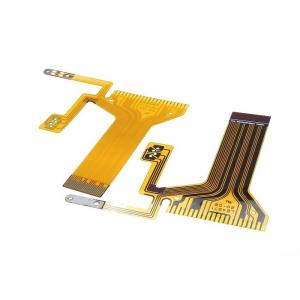Customized Flexible LCD Display FPC PCB 0.2mm 2 Layer PI Material Flexible Board
Add to Cart

Specification:
| Material | Polyimide, Copper Film |
| Layers | 2 L |
| Size | 18*16cm |
| Color | Yellow Film |
| Board Thinckness | 0.2mm |
| Copper Thinckness | 1Oz |
| Type | Flat Flexible FPC Cable |
| Surface Finish | Immersion Gold |
Quick Details:
Place of Origin:Guangdong, China
Brand Name:XCE Flex PCB
Base Material:Polyimide,Copper Film
Copper Thickness:1/2oz
Board Thickness:0.1mm 0.15mm
Min. Hole Size:0.25mm
Min. Line Width:0.1mm
Min. Line Spacing:0.07mm
Surface Finishing:HASL-LF,Immersion Gold,Immersion silver,Gold-plated, Nickel plated
Item:Customized Flexible LCD Display FPC PCB 0.2mm 2 Layer Flexible Board
Type:Flat Flexible FPC Cable
Solder mask color:Yellow Film
Solder temperature:260degree/10S
Surface resistance:<1.0*10(11)
Bending:Match with IPC standard
Chemical:Match with IPC standard
Single size:18*16cm
Application:Auto, GPS, LCD, LED, medical, industry etc
Flex circuits have recently gained huge popularity due to the fact that they can be shaped, bent, twisted, and folded into limitless configurations.
Both the rigid PCBs and flexible PCBs however serve the same ultimate function, which is connecting various electrical and mechanical components together.
When to Use Rigid PCB and When to Use Flexible PCB
If we compare the price of Rigid PCB and Flex PCB, Rigid PCBs typically cost less than flex circuits.
“Typically” because if we consider the total cost of ownership there are some applications that, when using flexible PCBs, may be less expensive as compared to using rigid PCBs.
The flex circuits eliminate the need for some components such as connectors, wire harnesses, and other circuit boards. So by removing these components from a design, material cost, labor and assembly cost, and scrap cost are all reduced.
Many electronic devices (laptop and desktop computers,audio keyboards, solid-state drivers (SSDs), flat-screen TVs and monitors, children’s toys, and various electronic gadgets) employ rigid PCBs instead of flexible PCBs.
However, flex circuits may be found in ultra-compact and/or high-performance devices, including GPS units, tablets, smart phones, cameras, and wearables. It is also found in some low-tech applications such as under-the-counter LED lights .
It is also possible to use a flex circuit and a rigid circuit together—as a unified PCB . This approach, perhaps, provides the best of both worlds.
What Are Flexible PCBs Used For?
A flex PCB is essentially the same thing as a non-flex board except the flexible PCB uses a flexible base material to make its circuit connections. This is most helpful for products that will likely not be stationary devices. The durability and size of flexible PCBs, as well as the shrinking sizes of electronics, has resulted in their adoption by a growing number of industries. Just a few of these industries and applications include the following:
Automobiles: With the automotive industry increasingly turning toward electronic components, circuits that can handle the vibrations and stresses of a vehicle’s interior are more important than ever. Flexible PCBs offer a valuable option for the industry, providing a durable yet cost-effective option.
Consumer Electronics: Flexible PCBs are typically used in small electronic products like cell phones, tablets, cameras, video recorders and other similar smaller gadgets on the market today. These products may be transported or handled regularly, making the flexible PCB’s resistance to shock and vibration a useful feature.
High-Speed Digital, RF and Microwave Applications: The reliability of flexible PCBs makes them ideal for handling high-frequency signals.
Industrial: Industrial electronics often handle massive amounts of vibration and stress, so flexible PCBs with shock absorption and anti-vibration capabilities are a must.
LED: LED lighting is massively popular today in both residential and commercial applications. This is primarily because of LED technology’s incredible power efficiency. Heat is often the only concern, which can be mitigated with flexible PCBs and their effective heat transfer properties.
Medical Systems: Small and dense electronic designs are becoming increasingly important in the medical industry, with handheld surgical technology and even electronic implants growing in popularity. Flexible PCBs can be applied in both cases, meeting the durability and size requirements of surgical technology and the necessary flexing ability for implants.
Power Electronics: Another benefit of flexible PCBs is that they can be coupled with highly flexible, thin layers of copper, which means the board can handle heavier power currents. This is especially important in devices that will require more power to operate at full capacity, like those found in the power electronics industry.

